Scallions, green onions, and spring onions are immature onions that have not formed a white bulb.
What’s the difference between scallions, green onions, and spring onions? There is little to no difference.

Scallions
Scallions are the youngest or least mature of onions with very thin white bases no wider than their long, straight green stalks. Scallions offer no hint at the development of a bulb-like base. Pulled from the ground a scallion resembles a large chive. Scallions are very mild flavored. Both the white base and the green stalk of the scallion are easily eaten raw. You can slice or chop scallions and add them raw to green salads. You can also serve them on the raw vegetable tray or sprinkle them raw as a topping for sauces.
Scallions can be cooked whole or chopped, but they will require no more than a couple of minutes of cooking. (Sauté or pan steam them on low heat in butter or water.) Scallions can be used as a substitute for chives in many recipes. Scallions are sometimes called green onions or bunching onions, but for onion lovers and growers, there is a difference. A green onion or bunching onion has gained the hint of a bulb with maturity; a scallion has not.
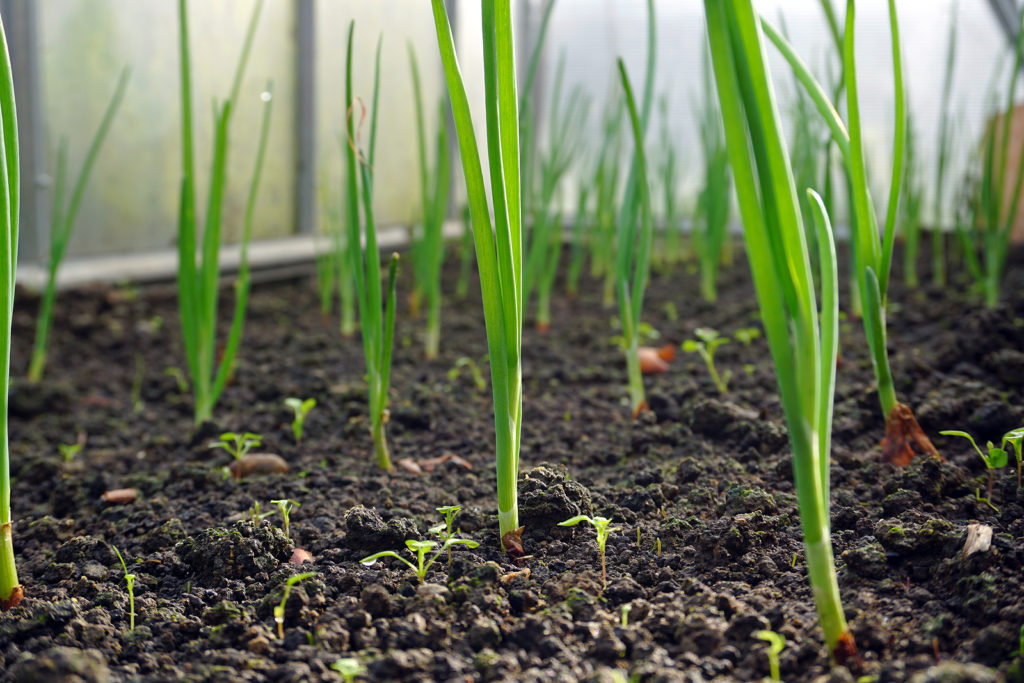
Green onions
Green onions have long, green, delicate stalks and small, very, very slender, white bulbs. The bulb of a green onion is slightly defined. Green onions come out of the ground early in their lives, usually in spring. They are mild tasting having not been alive long enough to gain much pungency. Green onions can be used sliced or chopped raw in green salads or creamy salads like potato salad, pasta salads, or atop baked potatoes.
Green onions are sometimes called bunching onions. When onion seeds are planted densely they grow so close or bunched together that the bulbs have little chance of fully maturing and rounding out. Green onions are green onions in the United States; in England and Australia, the green onion is also called a spring onion. Green onions are sometimes also called scallions. (But, now, you know there is a difference even if ever so slight.)
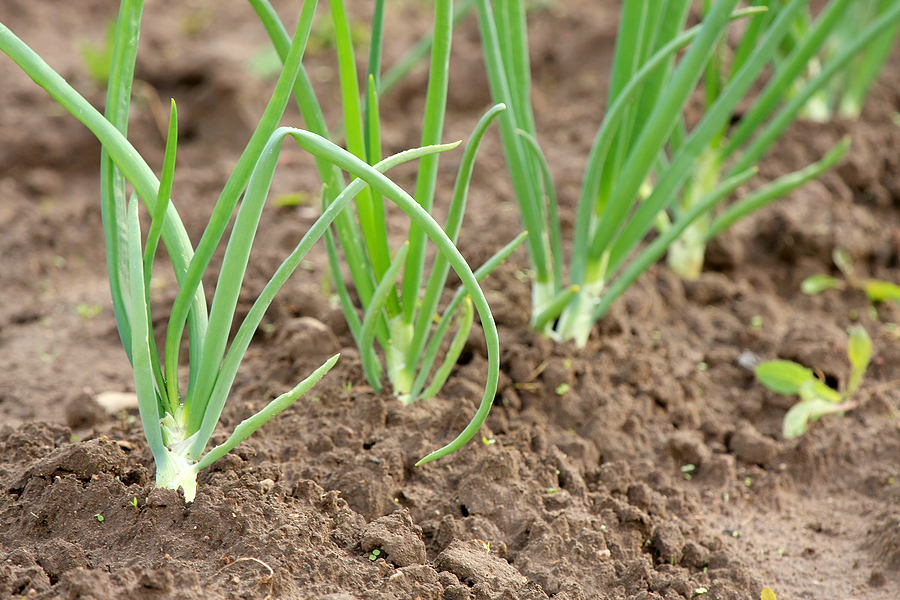
Spring onions
Spring onions have slightly rounded bulbs that are more defined and just a bit larger than the more slender green onions. Spring onions are the most pungent tasting of young onions with a bit more bite than green onions. Remember, most onions gain their sharp taste as they mature. Spring onions can be used raw or cooked. Because raw spring onions are pungent, taste them to make sure their flavor does not overpower more delicate flavors. You can slice raw spring onions thinly onto green salads.
Cooked spring onions—usually sautéed—will be more delicately flavored as a result of the cooking process and are a good combination with other spring and summer vegetables. The spring onion is distinctly different than a green onion to many growers and onion lovers in the United States. In England and Australia, spring onion and green onion are most often considered the same bird.
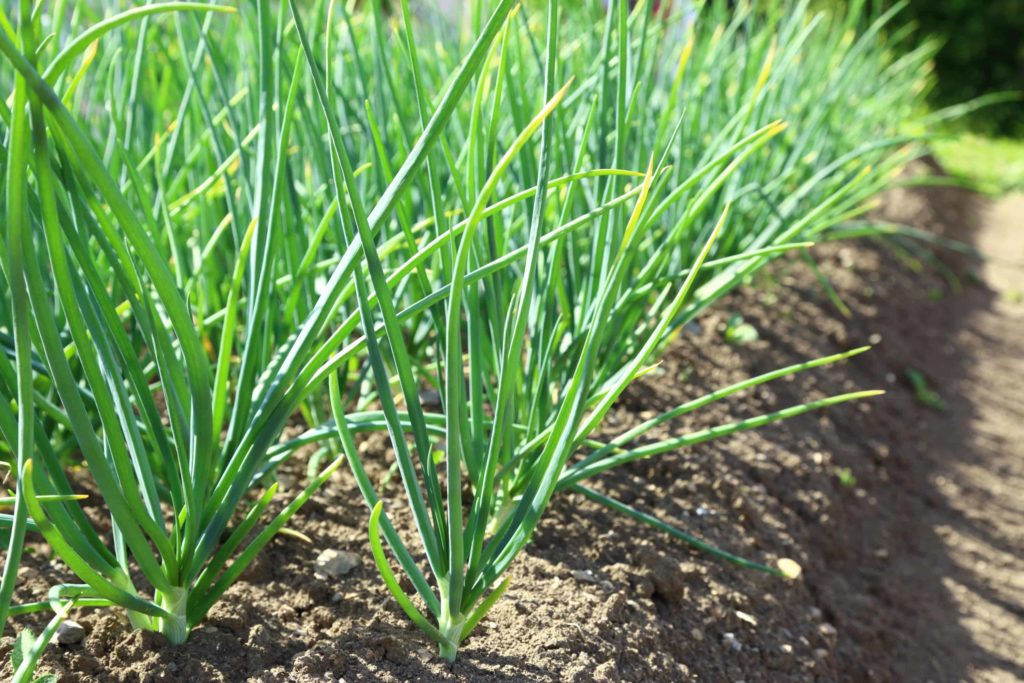
Growing green onions, spring onions, and scallions
- To grow green onions, spring onions, and scallions, you can choose an onion variety specially adapted for use as green onions, choose varieties described as scallions or bunching onions. These green or bunching onions are grown for their green tops, not bulbs. These varieties will have a milder flavor than regular onions. Many scallion varieties will be ready for harvest in about 60 days from seed sowing.
- To grow green onions, spring, onions, and scallions from regular bulbing onions (1) plant seeds; (2) plant baby plants; (3) plant sets; sets are bulbs about the diameter of a dime that was grown last year and harvested at a small size specifically for planting as sets the following year. If you harvest these bulbing onions while young before bulbs form and use them for their green tops–these are also called scallions.
- Botanical names for green onions, spring onions, and scallions: Allium cepa (globe onion, green onion, scallion); Allium fistulosum (bunching onion, scallion); Allium spp.
- Allium fistulosum plants are commonly grown as scallions. They form hollow cylindrical stalks that are similar in appearance to chives, and they are used in the same way. These plants do not form bulbs; they have a slight bulge at the bottom of a white stalk or shank.
- Green onion, spring onion, and scallion varieties are grown as annuals; they are harvested about 50 to 70 days after they are planted. If not harvested, scallions spread or “bunch” in clumps; the roots form new plants if not removed from the ground.
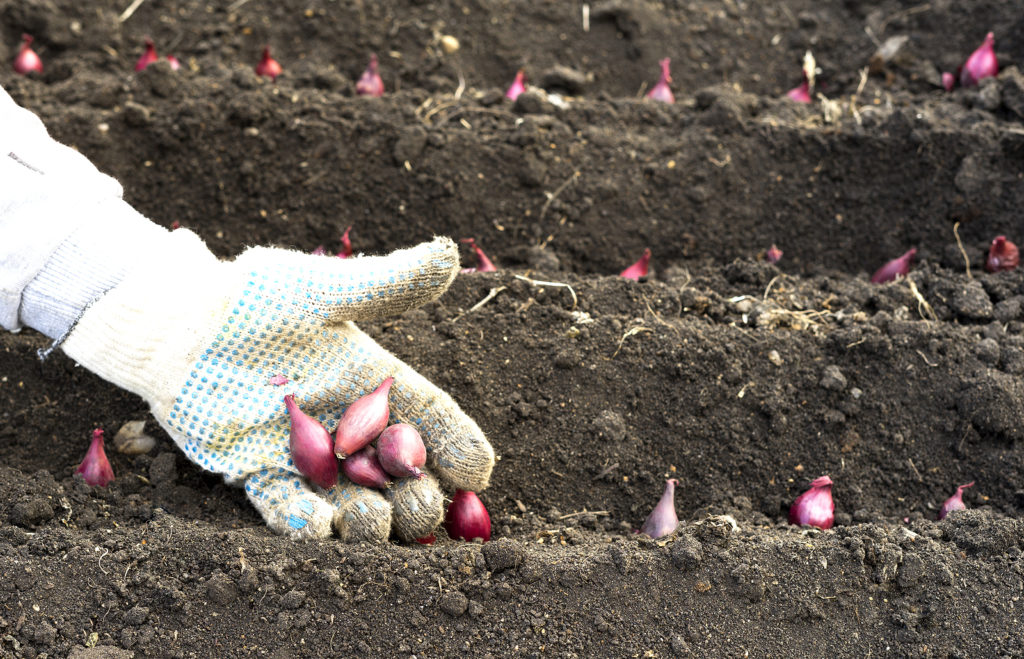
When to sow seeds outdoors
- Green onions, spring onions, and scallions are commonly started directly in the garden from seed.
- Sow seeds outdoors as soon as the soil is workable in early spring. Plants started in early spring can be harvested in late spring or early summer.
- You can also direct sow seeds in late summer or early fall for an autumn harvest.
- In a cold-winter region sow seeds or set out transplants in late fall and winter them over; you will have plants to harvest in early spring.
- In mild winter regions, green onions, spring onions, and scallions can be grown through the winter.
When to start seeds indoors
- Sow seeds indoors four weeks or more before the average last frost date in spring.
- Start seeds in seed trays or small pots using a sterile seed starting mix or potting soil.
- Set trays or pots on a sunny windowsill or under grow lights. Turn seedlings every couple of days so that they grow straight.
- You can begin harvesting indoors or transplant seedling to the garden after the last average frost date.
Where to plant outdoors
- Plant green onions, spring onions, and scallions in full sun.
- Plant in humus-rich, well-drained soil. Add aged compost to the planting bed before planting. You can also add a granular balanced organic fertilizer to the planting bed ahead of planting.
- Loosen the soil several inches deep and enrich each planting hole with compost or work compost into the top several inches of soil.
- In rainy regions or where the soil is slow to drain, plant on mounded or raised beds. Beds rich in organic matter will drain quickly.
Planting and spacing seeds
- Sow seeds 1 inch apart in wide rows.
- Cover seeds or sets with 1/2 to 1 inch of finely worked soil, vermiculite, or sand. Firm the soil to be sure the seeds make contact with the soil. Then lightly moisten the soil.
- Plant sets just below the soil line and then apply a light mulch.
- Seeds can be planted thickly and thinned by harvesting.
- You can also plant onion sets rather than seeds.
- Seeds can be planted thickly and plants can be thinned by harvesting.
- It takes about 60 days from seed to harvest scallions.
Planting and spacing sets
- In spring and summer, plant sets just below soil level, and then apply a light compost mulch.
- In fall plant sets 2 to 4 inches (5-10cm) deep and cover with several inches of mulch.
- Planting sets will bring a harvest of scallions in a few weeks.
Container growing
- Grow green onions, spring onions, and scallions in a pot that is at least 12 inches (30cm) across and 8 inches (20cm) deep.
- Use compost-rich potting soil.
- Scatter seeds and then gradually thin young scallion plants to about 2 inches apart. Allow enough room between plants for good air circulation.
Succession planting
- Sow green onion, spring onion, and scallion seeds every 2 to 3 weeks to ensure continued harvest through the growing season.
Planting for autumn and winter harvest
- Sow green onion, spring onion, and scallion seeds in late summer or fall so that the seedlings become established before the dormant period. Protect plants through the winter with mulch or grow them under the protection of a plastic tunnel.
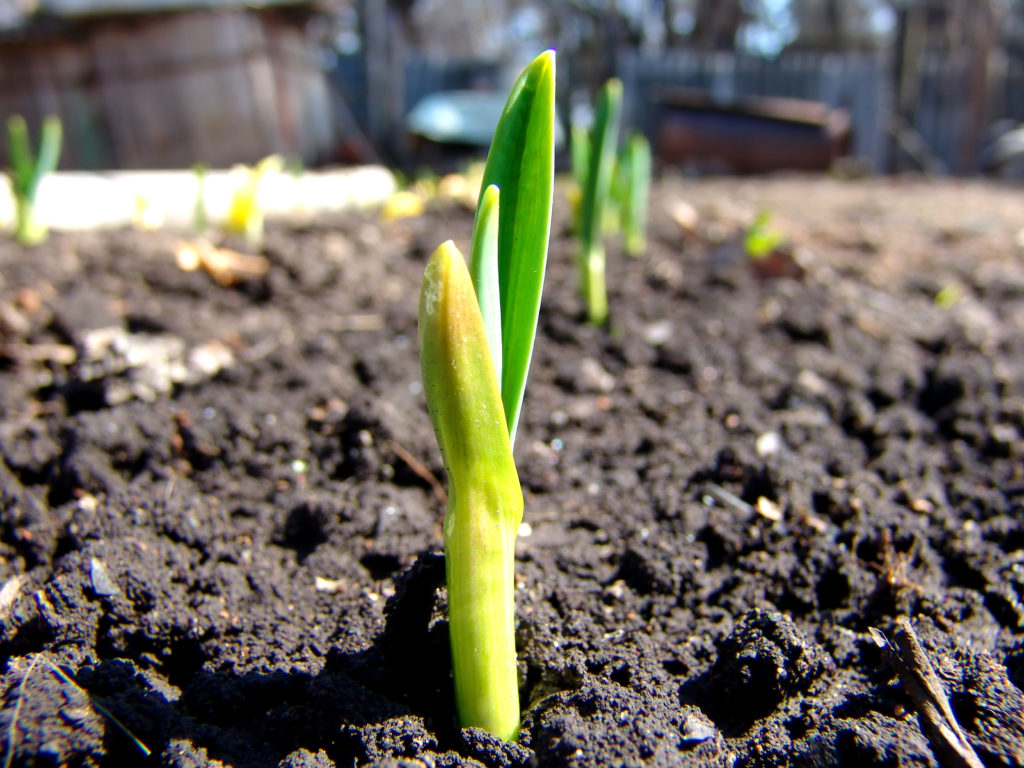
Caring for green onions, spring onions, and scallions
Watering
- Water green onions, spring onions, and scallions often but lightly at the soil level Avoid wetting the foliage which can lead to disease.
Feeding
- Feed with liquid fertilizer–kelp, fish emulsion–or a balanced organic fertilizer every three to four weeks
Care
- Mulch around young onions with aged compost or grass clippings to conserve moisture and add nitrogen to the soil.
- Mulch with straw in autumn to protect them from cold; this is especially important in Zone 5 and colder.
- Where the ground freezes in winter, pot up divisions and bring them indoors to a cool, bright spot to overwinter.
Weeding
- Green onions, spring onions, and scallions have a shallow root system and can not compete with weeds for moisture and nutrients. Remove weeds growing near by hand pulling or cultivating gently to avoid damaging roots. Check for weeds and remove them every couple of weeks.
Green onion, spring onion, and scallion pests and diseases
Pests
- Green onions, spring onions, and scallions can be attacked by many of the pests that attack onions. Use organic pest controls.
- Onion maggots (Delia antique) are small white larvae that bore narrow tunnels into roots. The maggots are the larvae of small gray flies. Remove and destroy infected plants.
- Leaf miners are black fly larvae that tunnel into leaves; exclude flies from laying eggs on young plants with floating row covers.
- Nematodes are slender, translucent worms that live in the soil and feed on roots; they can leave plants distorted and twisted. Crop rotation is the best way to control nematodes.
- Thrips are sucking insects that attack scallion shoots. Control thrips with neem oil, and insecticidal soap, or spray them off plants with a garden hose
Diseases
Young onions are susceptible to diseases that attack onion plants.
- Damping off is a fungal disease that causes young green shoots to wilt and die shortly after they emerge from the soil. Make sure there is good air circulation in the planting bed and do not overwater.
- Downy mildew is a fungal disease. Leaves develop yellow spots with fluffy fungs spots on the undersides. Destroy infected plants; drench the soil with compost tea; avoid wetting foliage.
- Leaf blight is a fungal disease. Leaves develop brown spots. Remove infected plants; space plants widely to increase air circulation.
- Onion smut is a fungal disease that attacks young seedlings. It causes blister-like lesions near the base of the plant and leaves become streaked. Some fungicides may be effective. Make sure there is good air circulation. Rotate crops each season.
- Pink root got is a fungal disease that caused roots to turn light pink then plants shrivel and become stunted. Plant early in the season to avoid this disease. Plant disease-resistant varieties.
- Rust is a fungal disease that causes rust-colored spots on leaves and stalks. Plant early in the season to avoid this disease and rotate crops.
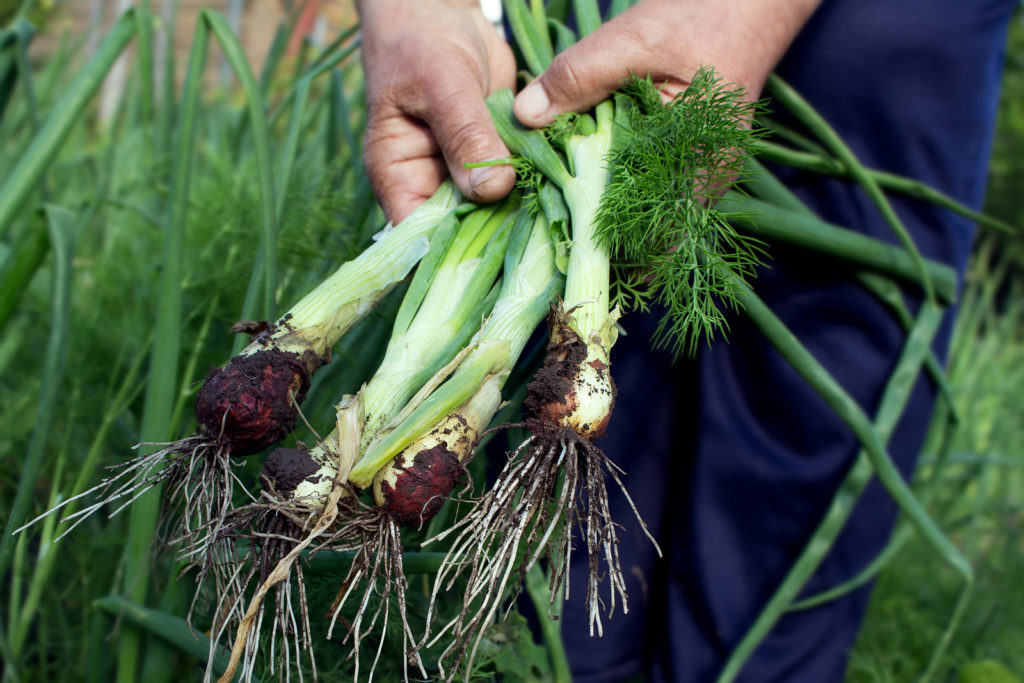
Harvesting green onions, spring onions, and scallions
- Harvest young onions when they are about as thick as a pencil and at least 6 inches tall.
- Use a trowel to uproot the plants. Avoid pulling on the plants; the stems break easily.
- With clumping varieties, harvest as many stems as you need, then replant the cluster.
- To increase the number of shoots or to start a new clump, separate single shoots and replant them.
- Replant clumps or single shoots in a new spot; this is a form of crop rotation to avoid diseases.
- To harvest scallions at the ideal size, succession plants them.
- Keep harvesting them as needed for fresh eating.
- Uproot the plant with a trowel; if you pull them, the stem break easily
- Harvesting scallions improve the growing conditions for the remaining plants by loosening the soil and removing competition.
Storing green onions, spring onions, and scallions
- Young onions will keep for about one week in the refrigerator, not longer.
- Stand the root end in a jar of water and place a plastic bag over the long green tops to keep them fresh.
- If the water gets murky, replace it with fresh water.
Green onions, spring onions, and scallions in the kitchen
- Young onions are mild flavored. The base and leaves of scallions can be used raw in salads, as a garnish, or in cooking.
- Use scallions to add a mild onion flavor to savory dishes.
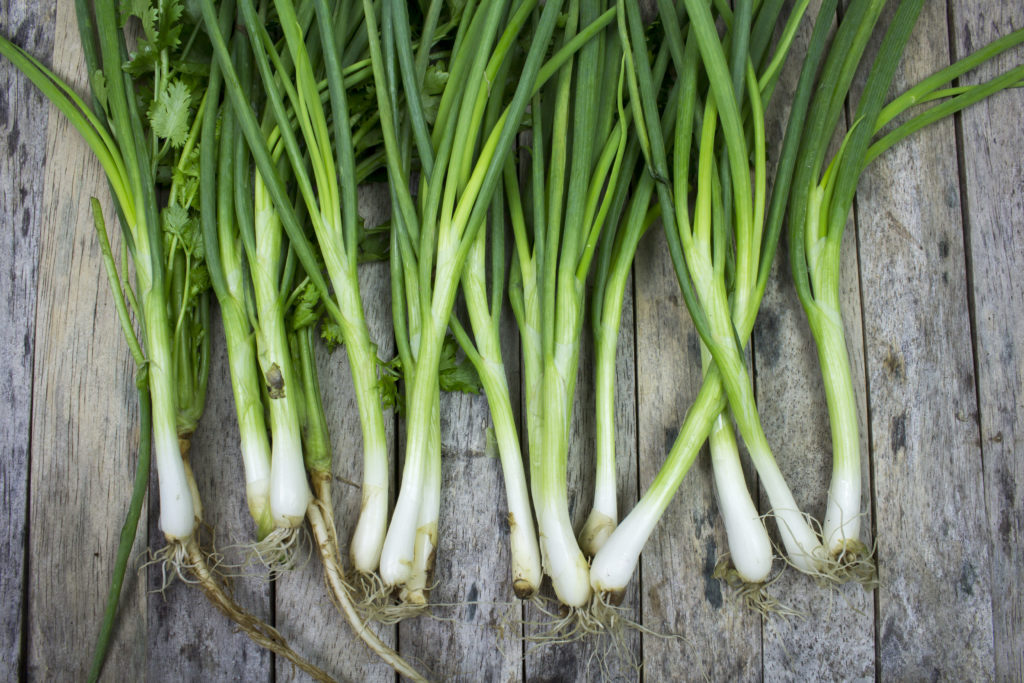
Green onions, spring onions, and scallions frequently asked questions
Q: What’s the difference between scallions, green onions, and spring onions?
A: There is no difference. They are all the same.
Q: What are scallions?
A: Several kinds of onions with long straight bulbs are used for scallions. You can harvest all varieties of onions immature before they form bulbs and call them scallions. You can also grow perennial bunching onions and call them scallions. Bunching onions form many small, narrow bulbs, or stalks, rather than one fat one.
Q: Why are bunching onions commonly grown as scallions?
A: Bunching onions form many narrow, bulbs or stalks, unlike globe onions which form one fat bulb. Bunching onions are a type of perennial onion. Once they are sown they will continue to divide on their own. They die back in winter and reappear in spring. When you grow scallions from bunching onions, leave some behind at harvest time; they will continue to grow and divide.
Q: What part of a green onion, spring onion, or scallion is edible?
A: All parts are edible–the green straight leaves, the long white stem or shank, and the root below.
Q: Will scallions survive through the winter?
A: Yes. Scallions grown from bunching onions are perennials and will die back in winter and reappear in spring.
Q: Can I grow scallions in winter?
A: Yes. In mild winter regions, scallions can be grown in planting beds throughout the winter. In cold-winter regions, grow scallions under the protection of a plastic tunnel or cold frame.
Green onion, spring onion, and scallion varieties to grow
- ‘Asagi Bunching’: high yield; mild flavor; 65 days to harvest.
- ‘Beltsville Bunching’: slight bulbs; hardy in winter; 65 days to harvest.
- ‘Deep Purple’: bunching type; red-colored shanks; 60 days to harvest from seed.
- ‘Emerald Isle’: strong straight tops; long white bulbless shank; heat tolerant; 64 days.
- ‘Evergreen Long White’: bunching type; hardy; plant in spring or fall; 60 days to harvest from seed.
- ‘Ishikura Improved’: bunching type; grows to 30 inches (75cm) tall; sow in a trench and then hill stems to keep them white; 50 days from seed.
- ‘Long White Bunching’: white shafts with bulbs; tolerant of fusarium and pink root; 70 days.
- ‘Red Baron’: bunching type; red stems, green leaves; 65 days from seed.
- ‘Red Welch Bunching: red, bulbless onions; 65 days.
- ‘Southport White Globe’: mild flavor; 65 days.
- ‘Tokyo Long White’: non-bunching; long stalks; 65 to 95 days from seed.
- ‘White Bunching’: 18-inch-long, white stalks; endures heat; 40 days.
- ‘White Lisbon’: resistant to heat and cold; 65 days.
- ‘White Spear Bunching’: long, slender white stalks; 60 days.
- ‘White Sweet Spanish Bunching’ slow to form bulb; mild flavor; 65 days.
- ‘Winter White Bunching’: excellent overwintering type; 60 days.
- ‘Yakko Summer’: withstands summer heat; 100 days.
- ‘Zippy’: hybrid, resistant to pink root; 65 days.
Also of interest:
How to Plant, Grow, and Harvest Onions
How to Plant, Grow, and Harvest Scallions
How to Plant, Grow, and Harvest Welsh Onions
Onion articles at Harvest to Table:
How to Grow Green Onions, Spring Onions, and Scallions
Growing Onion Bulbs: Pick the Right Variety for Your Garden
How to Plant, Grow, and Harvest Welsh Onions
How to Harvest and Store Onions
Onion Family Growing Problems: Troubleshooting
Onion Cooking and Serving Tips
Tasty Ways to Cook and Serve Shallots
How to Make Onion Soup with No Recipe
How to Plant, Grow, and Harvest Shallots
English Peas, Spring Onions and Roasted Almonds
Tropea Onion – The Red Torpedo
Garden Planning Books at Amazon:
- Vegetable Garden Grower’s Guide
- Tomato Grower’s Answer Book
- Vegetable Garden Almanac & Planner
- Kitchen Garden Grower’s Guide Vegetable Encyclopedia















